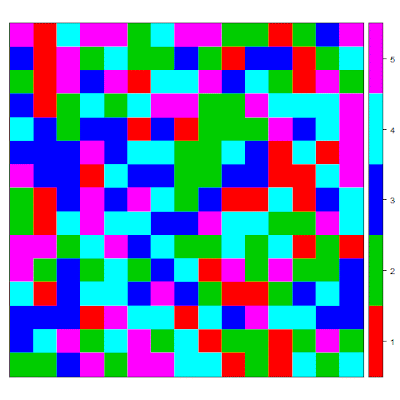(This article was first published on R snippets, and kindly contributed to R-bloggers)
While preparing for the new teaching semester I have created an implementation of NetLogo GenDrift P local in GNU R.The model works as follows. Initially a square grid having side size is randomly populated with n types of agents (denoted by colors).
Each agent randomly changes type (color) to one of its eight neighbors colors. In long run only one agent type remains due to random selection process (although it can take a long time if we set
side to a large value).
Here is the simulation code:
We can select if we want to see the animation on the screen or save it to file via animate option.library(lattice)
library(animation)# initialize simulation
# side - square grid size
# n - number of agent types (from 2 to 6)
init <- function(side, n) {
matrix(sample.int(n, side * side, TRUE), side)
}
# plot simulation state
# s - simulation state
# n - initial number of agent types
do.plot <- function(s, n) {
print(levelplot(s, at = (0:n) + 0.5,
col.regions = 1 + (1:n),
scales = list(draw = F), xlab = "", ylab = "",
colorkey = list(tick.number = n)))
}# perform one step of simulation
# state - simulation state
sim.step <- function(state) {
updated <- FALSE
side <- dim(state)[1]
moves_x <- rep(-1:1, 3)[-5]
moves_y <- rep(-1:1, each = 3)[-5]
sequence <- sample.int(length(state))
for (i in sequence) {
x <- 1 + (i - 1)%%side
y <- 1 + (i - 1)%/%side
ref <- sample.int(8, 1)
ref.x <- 1 + (x + moves_x[ref] - 1)%%side
ref.y <- 1 + (y + moves_y[ref] - 1)%%side
if (state[x, y] != state[ref.x, ref.y]) {
state[x, y] <- state[ref.x, ref.y]
updated <- TRUE
}
}
list(state, updated)
}
go <- function(size, n) {
s <- init(size, n)
updated <- TRUE
for (i in 1:4) {
do.plot(s, n)
}
i <- 0
while (updated) {
i <- i + 1
do.plot(s, n)
out <- sim.step(s)
s <- out[[1]]
updated <- out[[2]]
do.plot(s, n)
}
print(i)
for (i in 1:4) {
do.plot(s, n)
}
}
set.seed(1)
animate <- FALSE # do we want to save animation?
side <- 15 # simulation grid will be side x side
n <- 5 # initial number of agent types
if (animate) {
ani.options(interval = 0.2)
saveGIF(go(side, n))
} else {
go(side, n)
}
The animation the code generates is presented below:
To leave a comment for the author, please follow the link and comment on his blog: R snippets.
R-bloggers.com offers daily e-mail updates about R news and tutorials on topics such as: visualization (ggplot2, Boxplots, maps, animation), programming (RStudio, Sweave, LaTeX, SQL, Eclipse, git, hadoop, Web Scraping) statistics (regression, PCA, time series, trading) and more...
